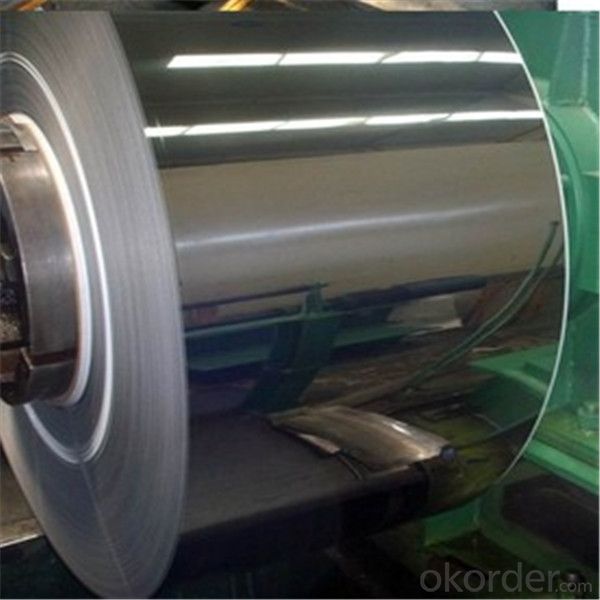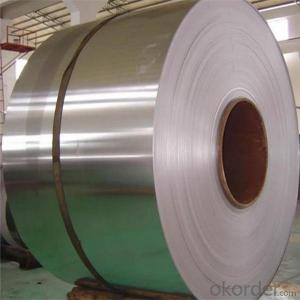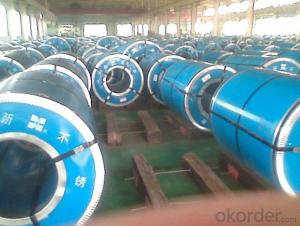Stainless Steel Coil Price Per KG in China
- Loading Port:
- Shanghai
- Payment Terms:
- TT OR LC
- Min Order Qty:
- 4 m.t.
- Supply Capability:
- 10000 m.t./month
OKorder Service Pledge
OKorder Financial Service
You Might Also Like
Item specifice
Detailed Product Description
Product Name: stainless steel coil
Features:
1) Grade: 430, 301,304, 316L, 201, 202, 410, 304
2) Specs: Thickness 0.3-3mm Width 20~ 480mm x C
We also produce other specification according to customer's requirements.
3) Executed Standard: JIS, ASTM, GB
4) Packing: plastic bag, weaving bag, wooden case or according to the customers
5) Applications: construction, decoration, machinery furniture, automobile, fluid transportation, Industry instrument, agriculture, kitchenware
6) Cold Rolling Thick:0.3mm-3.0mm Width:365-480
Specifications
Cold Rolled Stainless Steel Mill/Slit Coil
1. Grade: 200 & 300 series
200 seriers: 201,202, J4
300 seriers: 301, 304, 304L, 321, 316L, 309, 310S
2. Standard: JIS, ASTM, AISI, GB, DIN, EN, we usually use ASTM and GB Standard
3. Thickness: 0.14mm-3.0mm
4. Width: 10-700mm
5. Surface: 2B finished, BA finished
6. Hardness: soft, 1/4H, 1/2H, FH
7. Thickness Tolerance: +/-0.02mm
8. Width Tolerance: +/-10mm(mill edge)
Hot Rolled Stainless Steel Coil
1. Grade: 200 & 300 & 400 series
200 seriers: 201,202
300 seriers: 301, 304, 304L, 316L, 309, 310S,321
400 seriers: 410, 410S, 409L,430
2. Standard: JIS, ASTM, AISI, GB, DIN, EN, we usually use ASTM and GB Standard
3. Thickness: 2.4mm-6.0mm
200 series: 2.4mm-6.0mm
300 series: 2.4mm-6.0mm
400 series: 2.4mm-6.0mm
4. Width: 405mm-700mm
5. Surface: No1 finished, mill edge
6. Hardness: soft
7. Thickness Tolerance: +/-0.1mm
8. Width Tolerance: +/-10mm
9. Mills: Quanxing, Xingda

Producing Line of Stainless Steel Coil
1. 750mm 6-rolling mill (CR)
2. 850mm 2-rolling mill (HR)
5. 8 sets of bright annealing producing line (CR)
3. 8 sets of pickling and annealing line (HR)
6. 2 sets tension levelers
7. 2 sets degreasing cleaning lines
8. 4 sets slit cutting machine
9. 2 sets cutting plate machine
10. 1 set mulch applicator with PVC
11. 1 set wrapping machine

Applications
1.Automotive: Automotive trim and molding/Difficult-to-form exhaust-system components, tubular manifolds, mufflers/Exhaust manifold and other exhaust-system components, catalytic converter shells, clamps
2.Construction: Gutters and downspouts, roofing, siding
3.Kitchenware: Cooking utensils, dishwashers, ovens, range hoods, refrigerators, skewers
4.Chemical processing: Oil refinery equipment, oil burner and heater parts
5.Appliances: Hot water tanks, residential furnaces
6.Power generation: Heat Exchanger tubing
7.Farming:Dry fertilizer spreaders/Farm animal pens
- Q:Can stainless steel strips be hardened?
- Yes, stainless steel strips can be hardened. Stainless steel is a type of steel alloy that contains chromium, which enhances its resistance to corrosion and staining. While stainless steel is generally known for its excellent corrosion resistance and strength, it can also be hardened through a process called heat treatment. Heat treatment involves heating the stainless steel to a specific temperature and then rapidly cooling it to alter its microstructure and increase its hardness. This process is typically done through quenching, which involves immersing the steel in a liquid or gas medium, such as oil or water, to cool it quickly. By controlling the heat treatment process, it is possible to achieve different levels of hardness in stainless steel strips, making them suitable for various applications that require increased strength and durability.
- Q:What are the different types of edge finishes for stainless steel strips?
- Stainless steel strips can be given various edge finishes to improve both their appearance and functionality. Among these options is the straight edge finish, a simple straight cut along the strip's edge. This is commonly utilized in industrial settings where appearance is not a priority. Another frequently used edge finish is the deburred edge, which entails removing any sharp or jagged edges from the strip. This is crucial for safety purposes, as it prevents accidental cuts or injuries. For a more ornamental effect, the rounded edge finish is employed. This involves rounding off the edges of the strip to create a smooth and polished appearance. Often seen in architectural or decorative applications, it imparts a refined and elegant look to the stainless steel strip. Another popular choice is the beveled edge finish, where the edges of the strip are cut at an angle to create a chamfered or sloped edge. This is commonly employed when a seamless transition is required, such as when joining two strips together. Furthermore, there are edge finishes that involve applying a coating or treatment to the edge of the stainless steel strip. This can include the application of a protective film to prevent corrosion or the use of a colored coating for aesthetic purposes. Ultimately, the selection of an edge finish for stainless steel strips depends on the specific requirements of the application, whether it be functionality, safety, or aesthetics.
- Q:What are the different types of edges for stainless steel strips?
- The different types of edges for stainless steel strips include mill edge, slit edge, deburred edge, and rounded edge.
- Q:Are stainless steel strips suitable for conveyor belts?
- Yes, stainless steel strips are highly suitable for conveyor belts due to their durability, heat and corrosion resistance, and high strength-to-weight ratio. They can withstand heavy loads, extreme temperatures, and harsh environments, making them an excellent choice for various industries that require reliable and long-lasting conveyor systems.
- Q:Are stainless steel strips suitable for heat treatment processes?
- Yes, stainless steel strips are suitable for heat treatment processes. Heat treatment can help improve the mechanical properties, such as hardness and strength, of stainless steel strips. Different heat treatment processes, such as annealing, tempering, and quenching, can be used to achieve specific material properties and desired outcomes in stainless steel strips.
- Q:How do stainless steel strips handle thermal expansion and contraction?
- Stainless steel strips are known for their excellent thermal expansion and contraction handling capabilities. Due to the nature of stainless steel, which is a highly stable and resilient material, it can withstand extreme temperature changes without significant distortion or damage. When exposed to heat, stainless steel strips expand gradually and uniformly, allowing them to maintain their shape and structural integrity. This expansion is relatively low compared to other metals, which reduces the risk of warping or buckling. Similarly, when subjected to cold temperatures, stainless steel strips contract evenly, ensuring they can adapt to the changing conditions without compromising their strength. The exceptional thermal expansion and contraction properties of stainless steel strips make them suitable for various applications, particularly those involving temperature fluctuations. This includes industries such as construction, automotive, aerospace, and manufacturing, where the material is commonly used for structural components, fasteners, and heat exchangers. It is important to note that while stainless steel is highly resistant to thermal expansion and contraction, it is not entirely immune to the effects of extreme temperature changes. Proper engineering and design considerations should always be taken into account to ensure the material's performance is optimized and potential issues are minimized.
- Q:Can stainless steel strips be used in power generation plants?
- Yes, stainless steel strips can be used in power generation plants. Stainless steel is a versatile and highly durable material that is resistant to corrosion, heat, and pressure, making it ideal for various applications in power generation plants. One common use of stainless steel strips in power plants is for the fabrication of heat exchangers. These devices are crucial for transferring heat from one medium to another, such as converting steam into electricity. Stainless steel's resistance to corrosion and high-temperature environments makes it an excellent choice for heat exchanger tubes, ensuring their longevity and efficiency. Stainless steel strips are also utilized in the construction of various components in power plants, including valves, pumps, and piping systems. The material's strength, resistance to corrosion, and ability to withstand high-pressure environments make it suitable for these critical applications. Furthermore, stainless steel strips are often used in the manufacturing of turbine blades and other parts in steam and gas turbines. These components are exposed to extreme temperatures and high mechanical stresses, and stainless steel's ability to retain its strength and shape under such conditions makes it a reliable choice. In addition to its physical properties, stainless steel is also favored in power generation plants due to its hygienic properties. It is easy to clean and maintain, ensuring that the equipment remains free from contaminants and does not compromise the plant's operations. In conclusion, stainless steel strips are commonly used in power generation plants due to their corrosion resistance, high-temperature tolerance, strength, and hygienic properties. From heat exchangers to turbine components, stainless steel is a versatile material that contributes to the efficiency and reliability of power generation processes.
- Q:What is the conductivity of stainless steel strips?
- Stainless steel strips have relatively low electrical conductivity compared to other metals due to their high resistance to electrical flow.
- Q:Can stainless steel strips be coated with protective films?
- Yes, stainless steel strips can be coated with protective films. Protective films are commonly used to safeguard stainless steel surfaces during transportation, storage, and fabrication processes. These films are designed to provide temporary protection against scratches, abrasions, dirt, and other forms of damage. The films are typically transparent or translucent, allowing for easy inspection of the stainless steel surface while providing effective protection. They can be easily applied and removed, leaving the stainless steel strip in its original condition. Protective films are widely used in various industries, including automotive, construction, electronics, and appliances, to ensure that stainless steel products maintain their pristine appearance until they are ready for use.
- Q:Are stainless steel strips easy to form and shape?
- Yes, stainless steel strips are relatively easy to form and shape. Stainless steel is known for its excellent formability, which means it can be easily manipulated into various shapes and sizes without losing its structural integrity. This is due to its unique composition, which includes a high percentage of chromium that provides corrosion resistance and makes it more malleable compared to other types of steel. Additionally, stainless steel strips can be cold worked, meaning they can be bent, twisted, and stretched at room temperature without the need for heat treatment. These characteristics make stainless steel strips a popular choice in various industries, such as automotive, construction, and manufacturing, where they are used for applications that require precise shaping and forming.
1. Manufacturer Overview |
|
|---|---|
| Location | |
| Year Established | |
| Annual Output Value | |
| Main Markets | |
| Company Certifications | |
2. Manufacturer Certificates |
|
|---|---|
| a) Certification Name | |
| Range | |
| Reference | |
| Validity Period | |
3. Manufacturer Capability |
|
|---|---|
| a)Trade Capacity | |
| Nearest Port | |
| Export Percentage | |
| No.of Employees in Trade Department | |
| Language Spoken: | |
| b)Factory Information | |
| Factory Size: | |
| No. of Production Lines | |
| Contract Manufacturing | |
| Product Price Range | |
Send your message to us
Stainless Steel Coil Price Per KG in China
- Loading Port:
- Shanghai
- Payment Terms:
- TT OR LC
- Min Order Qty:
- 4 m.t.
- Supply Capability:
- 10000 m.t./month
OKorder Service Pledge
OKorder Financial Service
Similar products
New products
Hot products
Hot Searches
Related keywords





























